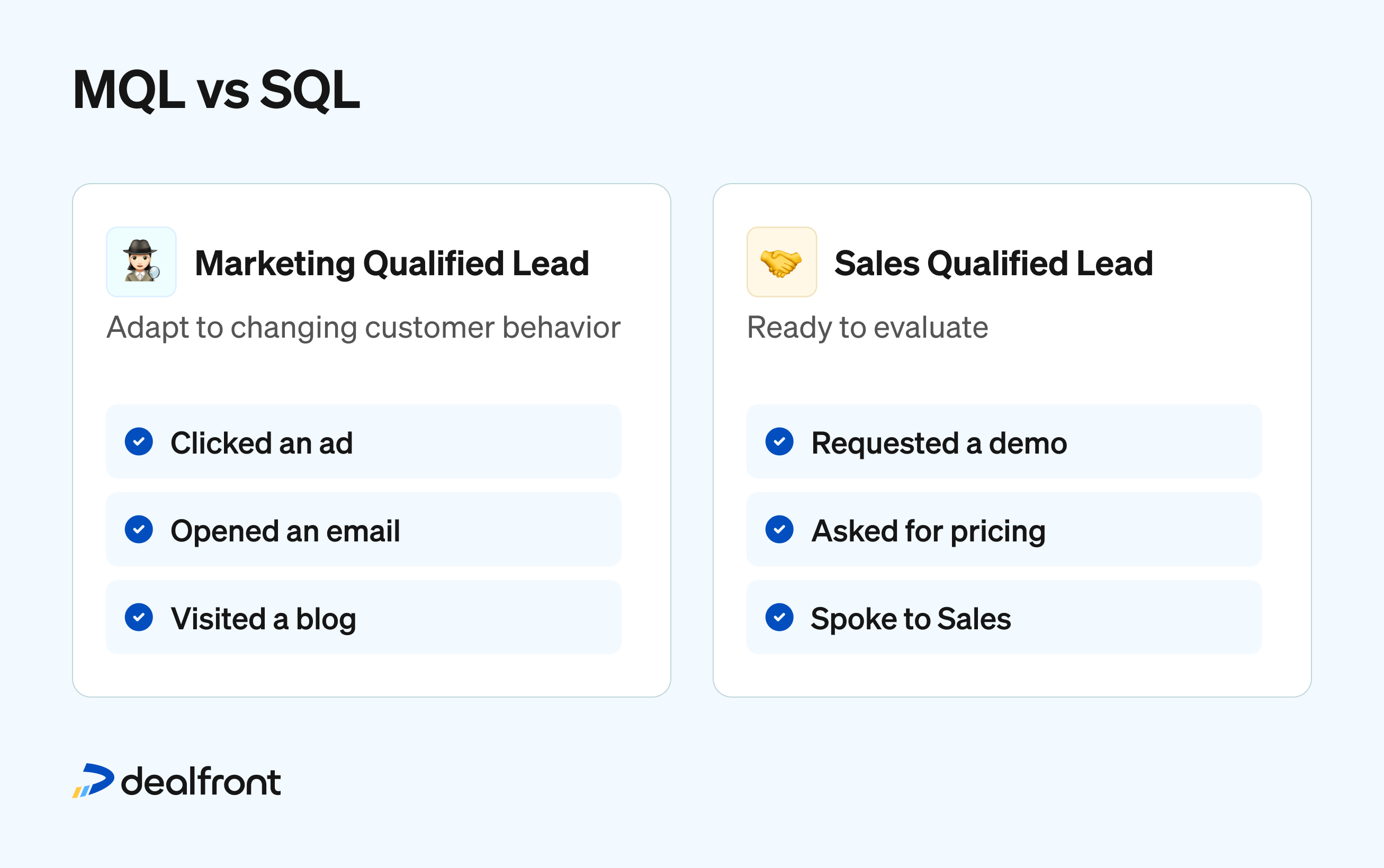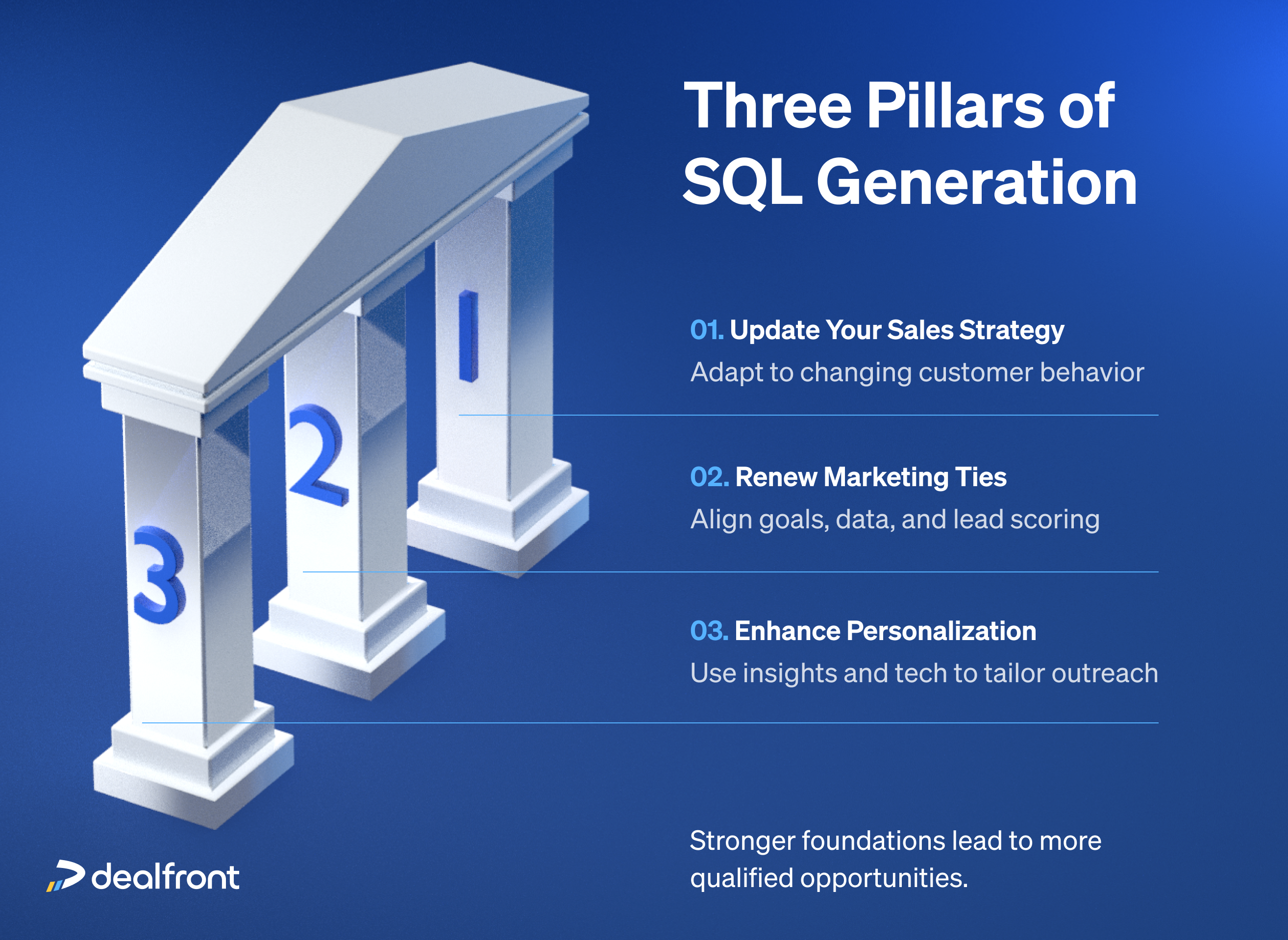60-Second Summary
Understanding the differences between MQLs, SALs, and SQLs is essential for aligning marketing and sales to close more deals effectively. Prioritizing qualified leads ensures teams focus on the right opportunities and improve conversion rates throughout the funnel.
Key distinction: SQLs have expressed purchase intent and are vetted by both sales and marketing, unlike MQLs which are only marketing-engaged and SALs which are pending sales approval.
Process framework: Use lead scoring, behavioral analysis, and BANT criteria to determine readiness, then apply personalized nurturing tactics to move leads through the funnel.
Improved efficiency: Differentiating lead stages boosts alignment between sales and marketing, optimizes resource allocation, and enhances visibility across the sales funnel.
Qualify with precision: Regularly review your sales strategy, reconnect sales and marketing around shared data and metrics, and use personalized interactions to boost SQL conversions.
Does this problem sound familiar to you? If so, it's time to adjust your approach and focus on sales qualified leads (SQLs). But what is an SQL and how does it compare to other types of leads? Let’s explore that and more.
What is a sales qualified lead?
Businesses use different lead descriptions that relate to a customer’s progress through the customer journey. It’s easy to get confused by the similarity of terms such as “marketing qualified lead” and “sales qualified lead”. We’ll look at the differences between the two later, but let’s start with a sales qualified lead definition.
The term applies to prospective customers that have been assessed by both sales and marketing. SQLs are different from other business leads because they have expressed purchase intent. They’re no longer simply considering your offering. They see you as a strong solution for relieving their pain points.
Determining SQLs involves a detailed process of assessing each lead individually. You’ll look at factors such as their decision-making authority and their previous interactions with your business.
Although this procedure might sound time-consuming, it helps you to understand leads much more clearly. You can pursue leads feeling much more confident of success.
SQL vs MQL: The differences
To properly understand qualified sales leads, it's useful to compare them to marketing qualified leads.
What is a marketing qualified lead?
Marketing qualified leads (MQLs) are generated by your marketing team after fulfilling certain criteria. They might, for example, have clicked an ad on social media or responded to a marketing email.
They’ve expressed interest in your product or service, but they’re not yet ready to consider a purchase.
Key differences between SQLs and MQLs
So, when it comes to marketing qualified leads vs sales qualified leads, they represent two different stages of a lead’s journey.
An MQL is interested in your business and, with enough care, can become an SQL. Not all MQLs will reach this stage, but by avoiding “jumping the gun” and pursuing leads too early, you’ll have a stronger chance of closing deals.
SQLs and MQLs also involve different departments. As mentioned, MQLs are generated by the marketing department. SQLs are assessed by the sales team.
Both departments have their own criteria for qualifying leads. Marketing will often set predetermined goals, while sales will create an assessment criteria.

SQL vs SAL: The differences
Sales accepted leads (SALs) are another important form of lead. Let’s look at SALs in more detail and see how they compare to SQLs.
What is a sales accepted lead?
A sales accepted lead (SAL) is a lead that sales have reviewed after being handed off by the marketing team, and agreed is a worthwhile one to pursue. This process helps ensure a higher quality of lead in the final part of the funnel so that sales have the highest chance of success.
Key differences between SQLs and SALs
SALs are found at a stage in the funnel between MQLs and SQLs. The marketing team believes these leads to be sales-ready, but the sales team needs to assess them before they can move to the next stage of the funnel.
SALs provide an extra layer of quality assurance. Instead of accepting every lead provided by the marketing team, sales can focus on successful outcomes.
For a SAL to be considered an SQL, it must receive an extra assessment. Usually, this involves contacting a lead by email or phone call.
Why is it important to differentiate SQLs from MQLs
We’ve explored the differences between SQLs and MQLs. But why should you differentiate between these two types of leads?
Here are some of the reasons that it's important to separate your leads:
1. Higher chances of success
Differentiating between SQLs and MQLs improves your sales team’s chances of success.
MQLs are interested in your business and want to learn more. In most cases, however, they’re not ready to commit to a purchase. By pursuing these leads too early, you’ll use time and resources and probably not get the results you need.
SQLs, on the other hand, have gone through a clear qualification process. Since being classed as an MQL, they’ve been screened to become an SAL. SQLs have received a final form of assessment on top of this. Your sales team has taken the time to get to know these leads—they’ll likely have a much higher success rate with SQLs compared to other leads.
2. Better allocation of resources
By separating SQLs and MQLs, you allow your sales and marketing teams to focus on their strengths. The clue is in the names: Sales and marketing.
It’s the marketing team’s job to analyze the behavior of users who interact with your campaigns. They’ll know the tell-tale signs signifying that a prospect is interested in your brand.
By focusing on MQLs, marketing can deliver a strong list of leads to your sales team. Sales can then give their full attention to their core goal—selling. They’ll have more time to get to know leads and create stronger sales strategies.
3. More efficiency throughout the funnel
Separating MQLs and SQLs provides greater visibility over different stages of the funnel. MQLs focus on the awareness and interest stages of the funnel. SQLs, on the other hand, focus on the decision and action stages.
Thanks to this visibility, you can monitor customer journeys throughout the funnel more easily. You can see where things are going to plan and where roadblocks hinder the progress of leads. You’ll know where to alter your strategy to reduce funnel abandonment.
4. Improves cross-departmental collaboration
Marketing and sales work best in tandem, sharing insights, and working together to create consistent messaging across all channels. But too often, there’s not enough collaboration between these two departments, hindering rather than helping your progress.
Having separate processes for MQLs and SQLs helps create dialog between both departments. When you align sales and marketing, you can create a more unified approach for chasing leads. Rather than only focusing on departmental goals, teams will work towards wider business objectives.
How to move a lead from marketing to sales qualified
As we’ve established, the process of moving an MQL to an SQL involves comprehensive review and qualification.
Here are some lead generation tips for moving a lead from marketing qualified to sales qualified. You might use some or all of the tactics listed below:
Lead scoring
When sales prospecting, your team will assign a score to each lead. Generally, this is a number between 0-100, but the overall scoring range is entirely up to you.
The criteria for scoring leads should align with your ideal customer profile and the kind of behaviors that help further your business goals.
Below are some example elements that might influence your lead scoring model:
Professional information - Consider a lead’s career. Do they work in a relevant industry? Do they have the rank to influence a purchasing decision?
Predictive analytics - Modern businesses can leverage artificial intelligence to create more accurate lead scoring. Predictive analytics can use current and historical trends to predict how customers might behave in the future.
Negative criteria - Alongside what you want to see from a customer, consider factors that might make them lose points. A lead might lose points, for instance, if they have recently unsubscribed from your mailing list.
Behavioral analysis
Behavioral analysis involves looking closely at a prospect's previous interactions with your business. Has a lead exhibited behavior that indicated a strong purchase intent?
For example, they might have signed up for a newsletter, booked a meeting with the sales team, or enlisted in a free trial.
Effective analysis requires having the right tool to unpack user behavior and deliver actionable insights. Dealfront solutions, for instance, can help you monitor intent signals.
These alert you whenever a lead carries out a key interaction, such as subscribing to your mailing list. This way, you’ll always have an overview of your most valuable leads.
BANT analysis
BANT analysis is another method for assessing the quality of your leads when sales prospecting. BANT looks at the following elements when evaluating each lead:
Budget - Do they have the necessary funds to support investing in your product or service? Prospects misaligned with budgets are less likely to invest.
Authority - Does a prospect rank highly enough to make a purchase decision? A junior employee might be very interested in your product but lack the authority to make a purchase. It’s often better to focus on more senior leads.
Need - What are a prospect�’s pain points? Does your product help to overcome them? Most importantly, is a pain point a big issue or only a minor grievance for a lead?
Timeline - How long will it take for a lead to make a purchase? Some prospects can be convinced by a single phone call—although not often in B2B sales. Others can take weeks or even months of coaxing. Are you prepared to devote the necessary time to convert a prospect?
Lead nurturing
Once you’ve spent time assessing a prospect through lead scoring, behavioral analysis, or BANT analysis (or a mixture of them all), you can begin lead nurturing.
This is the process of convincing a customer to make an investment in your offering.
Lead nurturing can involve many different tactics, including:
Sending personalized emails with offers tailored to individual customers.
Retargeting your ads so that a prospect is frequently exposed to your brand.
Speaking with leads directly on the phone.
Inviting leads to webinars that promote your product or service.
Best practices for generating more sales qualified leads
Generating SQLs can be a difficult task. Here are some lead generation tips to enhance your strategy:
Update your sales strategy
A tried and tested sales strategy can work wonders for your business. Sooner or later, however, you’ll notice that results start to diminish.
That’s because customers change over time. They alter their habits and, crucially, have new expectations of how they expect businesses to interact with them. Your sales team will find it much harder to generate qualified leads if they’re working with an outdated strategy.
Begin by refamiliarizing yourself with your audience. Look at the data relating to customers in your CRM; what are their common pain points? What methods do they use to reach your business?
Pay particular attention to calls or interactions that didn’t go to plan. Is there a common roadblock preventing you from closing deals?
Use these insights to help inform new strategies. Review these regularly to make sure they stay relevant and up-to-date.
Renew ties with marketing
As we’ve mentioned, your sales team can only generate SQLs effectively if they communicate with marketing.
Try some of the following methods to boost collaboration between departments:
Establish clear shared goals for both departments. Make sure that these align to a set of relevant metrics.
Use the same lead scoring model to ensure a unified approach between both departments.
Create a “single source of truth” so that both departments use the same data. Make sure that data is shared between departments to improve each other’s strategies, avoiding data siloes.
Run team-building exercises so that members from both departments can better get to know each other.
Enhance your personalization efforts
We’re currently in the age of personalization. It’s no longer desirable to provide personalized experiences for customers; it's expected.
Ultimately, the better your customer journeys, the more likely customers are to consider purchasing.
You probably already offer some personalization, such as product recommendations or relevant discounts. Consider how you can build more personalization into your sales strategy.
Have sales teams get to know their leads on a deeper level. This will require some extra research. For instance, has a prospect’s company recently received some favorable press? An agent should congratulate them on their success.
To make this process as easy as possible for your agents, provide them with up-to-date technology. A modern CRM, for instance, can give access to relevant customer details at the click of a button.
This way, an agent can get quick access to customer information without needing to ask as many questions.

What happens once a lead is sales qualified?
Once enough lead nurturing has occurred, a lead is classed as sales qualified. Now, the sales team must do the difficult bit—close the deal.
Depending on the lead, this process can either be short or lengthy. It will involve answering questions, carrying out negotiations, and helping a lead understand the different parts of the payment process.
Strong patience and communication are essential here. Work at the customer’s pace; don’t try to rush them into a purchase. A strong, customer-centric approach that focuses on the needs of each lead individually puts the sales team in a strong position for success.
Correctly qualify leads and improve your conversion rates
There’s no point in wasting time chasing the wrong leads. You’ll be using resources that could be spent growing your business and improving conversion rates.
Without a proper qualification process in place, it's much harder to find valuable leads. That’s why identifying sales qualified leads is essential.
Of course, don’t just focus on SQLs. As we’ve explored, marketing qualified leads and sales accepted leads play equally important roles. Having a clear lead qualification process at each stage of the pipeline maximizes your chances of success.
With a clear strategy and a proper lead nurturing process, you’ll close more deals while building stronger customer relationships. So, why not get started?
Sales qualified leads FAQs
How can you generate sales qualified leads?
How can you generate sales qualified leads?
For a lead to be classed as “sales qualified”, it must first be “marketing qualified”. This means that a lead must have interacted with marketing materials in a way that suggests an interest in your brand. Marketing qualified leads are then assessed by the sales team to see if they can be classified as sales qualified.
How do I qualify a sales lead?
How do I qualify a sales lead?
There are several methods you can use to qualify sales leads. These include:
Carrying out lead scoring, where you assign a number to each lead based on your predetermined criteria.
Using behavioral analysis to track a user’s interactions with your brand.
Running a BANT analysis to see how closely a lead aligns to your ideal buyer persona.
How do I track the success of my lead qualification?
How do I track the success of my lead qualification?
To determine the success of your lead qualification, keep a close eye on the relevant metrics. Listed below are some sample metrics that you might choose to track:
Win rate - The percentage of leads that convert into paying customers.
Conversion rate - The percentage of leads that carry out key interactions and move to the next stage of the qualification process.
Cost of customer acquisition (CAC) - The amount your business spends acquiring new customers.
Customer lifetime value (LTV) - The amount of money a prospective customer will contribute throughout their relationship with your business.
